Feasible Exploration Study of Anti-Silicon Element Corrosion Coating for C/C Composites
Abstract
:1. Introduction
2. Experimental Section
2.1. Coating Preparation
- The C/C samples were cleaned ultrasonically for 6 min using an ultrasonic cleaning system (DY-040S-2, Ding Yu, Shenzhen, China) and then dried in an oven for 9 h.
- The cleaned C/C composite samples underwent sandblasting with a sandblasting machine (BH-PS1090DA-Z, Bai Hui, Wenzhou, China), using SiC particles (50 mesh size) as the abrasive material, for 3 s.
- The CZrSiO4-agglomerated powder with a particle size of 400 mesh was employed as the raw material for APS. The spraying process parameters were configured to include 1–4 deposition cycles, with each cycle lasting 2 s, resulting in the successful preparation of a ZSO coating on the surface of C/C composites. During the spraying process, a mixture of Ar and H2 was utilized as the working gas. Ar, a commonly used plasma gas, exhibits high ionization energy and stability. Under the influence of a high-voltage electric field, argon ionizes to form a plasma, providing a high-temperature and high-energy environment. H2, on the other hand, serves as a potent reducing agent, capable of establishing a reducing atmosphere at elevated temperatures. This atmosphere aids in removing oxides from the material surface, particularly preventing oxidation of the coating during the spraying process. The spraying parameters are listed in Table 1.
2.2. Corrosion Process
2.3. Microstructure and Phase Characterizations
3. Results and Discussion
3.1. Microstructure and Composition
3.2. Preheating Treatment of ZSO Coating
3.3. Corrosion Resistance of ZSO-Coatings Against Si and Its Oxides
3.3.1. Corrosion Resistance of ZSO-Coating Against Si
3.3.2. Corrosion Resistance of ZSO Coating Against SiO
3.3.3. Corrosion Resistance of ZSO Coating Against SiO2
4. Conclusions
- (1)
- The ZSO coatings, fabricated using atmospheric plasma spraying, exhibit optimal performance within a thickness range of 154–240 μm. After annealing at 1500 °C, significant reductions in crack density and porosity are observed, resulting in enhanced densification.
- (2)
- In an argon environment, the ZSO coatings demonstrate excellent resistance to silicon corrosion after 4 h of exposure at 1500 °C to Si, SiO, and SiO2. The coatings effectively prevent the penetration of silicon into the C/C substrate, with no permeable cracking, while maintaining strong interfacial adhesion with the C/C substrate.
Author Contributions
Funding
Institutional Review Board Statement
Informed Consent Statement
Data Availability Statement
Conflicts of Interest
References
- Zhao, Z.; Li, K.; Kou, G.; Li, W. Comparative research on cyclic ablation behavior of C/C-ZrC-SiC and C/C-ZrC composites at temperatures above 2000 °C. Corros. Sci. 2022, 206, 110496. [Google Scholar] [CrossRef]
- Zhao, Z.; Li, K.; Li, W. Ablation behavior of ZrC-SiC-ZrB2 and ZrC-SiC inhibited carbon/carbon composites components under ultrahigh temperature conditions. Corros. Sci. 2021, 189, 109598. [Google Scholar] [CrossRef]
- Li, J.; Zhang, Y.; Zhao, Y.; Zou, Y.; Lv, J.; Li, J. A novel (Hf1/3Zr1/3Ti1/3)C medium-entropy carbide coating with excellent long-life ablation resistance applied above 2100 °C. Compos. Part B Eng. 2023, 251, 110467. [Google Scholar] [CrossRef]
- Teng, L.; Shi, X.-H.; Wang, H.-H.; Li, W.; Yin, X.-M.; Li, H.-J. A new method to improve the laser-ablation resistance of Si-SiC coating on C/C composites: Laser cladding. J. Eur. Ceram. Soc. 2022, 42, 6425–6434. [Google Scholar] [CrossRef]
- Zhu, X.; Ou, C.; Li, T.; Zhang, Y.; Lv, J.; Chen, R. HfSi2-HfB2-SiC coating prepared at low temperature to protect SiC-coated C/C composites against oxidation at 1473–1973K. Ceram. Int. 2024, 50, 13490–13499. [Google Scholar] [CrossRef]
- Rendtorff, N.M.; Garrido, L.B.; Aglietti, E.F. Effect of the addition of mullite–zirconia to the thermal shock behavior of zircon materials. Mater. Sci. Eng. A 2008, 498, 208–215. [Google Scholar] [CrossRef]
- Rendtorff, N.M.; Grasso, S.; Hu, C.; Suarez, G.; Aglietti, E.F.; Sakka, Y. Dense zircon (ZrSiO4) ceramics by high energy ball milling and spark plasma sintering. Ceram. Int. 2012, 38, 1793–1799. [Google Scholar] [CrossRef]
- Kaiser, A.; Lobert, M.; Telle, R. Thermal stability of zircon (ZrSiO4). J. Eur. Ceram. Soc. 2008, 28, 2199–2211. [Google Scholar] [CrossRef]
- Rendtorff, N.M.; Garrido, L.B.; Aglietti, E.F. Thermal shock resistance and fatigue of Zircon–Mullite composite materials. Ceram. Int. 2011, 37, 1427–1434. [Google Scholar] [CrossRef]
- Drexler, J.M.; Shinoda, K.; Ortiz, A.L.; Li, D.; Vasiliev, A.L.; Gledhill, A.D.; Sampath, S.; Padture, N.P. Air-plasma-sprayed thermal barrier coatings that are resistant to high-temperature attack by glassy deposits. Acta Mater. 2010, 58, 6835–6844. [Google Scholar] [CrossRef]
- Feuerstein, A.; Knapp, J.; Taylor, T.; Ashary, A.; Bolcavage, A.; Hitchman, N. Technical and Economical Aspects of Current Thermal Barrier Coating Systems for Gas Turbine Engines by Thermal Spray and EBPVD: A Review. J. Therm. Spray Technol. 2008, 17, 199–213. [Google Scholar] [CrossRef]
- Yao, D.-J.; Li, H.-J.; Wu, H.; Fu, Q.-G.; Qiang, X.-F. Ablation resistance of ZrC/SiC gradient coating for SiC-coated carbon/carbon composites prepared by supersonic plasma spraying. J. Eur. Ceram. Soc. 2016, 36, 3739–3746. [Google Scholar] [CrossRef]
- Rosado, E.; Cañas, E.; Recio, P.; Sánchez, E.; Moreno, R. ZrSiO4/ZrO2 thermal barrier coatings produced by suspension plasma spraying. J. Eur. Ceram. Soc. 2024, 44, 460–470. [Google Scholar] [CrossRef]
- Salam, M.Y.A.; Ogunmuyiwa, E.N.; Manisa, V.K.; Yahya, A.; Badruddin, I.A. Enhancing phase charac-terization of AlCuCrFeNi high entropy alloys using hybrid machine learning models: A comprehensive XRD analysis. J. Mater. Res. Technol. 2025, 36, 592–605. [Google Scholar] [CrossRef]
- Li, Y.; Zeng, F.; Gao, B.; Chen, H.; Zhang, F.; Gu, Y. Durable anti-oxidation mechanism and failure analysis of the ZrSiO4 compound glass coating for carbon/carbon composites. Surf. Coat. Technol. 2018, 349, 233–241. [Google Scholar] [CrossRef]
- Ramaswamy, P.; Seetharamu, S.; Varma, K.B.R.; Rao, K.J. Thermal barrier coating application of zircon sand. J. Therm. Spray Technol. 1999, 8, 447–453. [Google Scholar] [CrossRef]
- Rudajevová, A. Thermal properties of plasma-sprayed ZrSiO4 material. Surf. Coat. Technol. 1994, 64, 47–51. [Google Scholar] [CrossRef]
- Butterman, W.C.; Foster, W.R. Zircon Stability and the ZrO2-SiO2 Phase Diagram. Am. Mineral. 1967, 52, 880–885. [Google Scholar]
- McPherson, R.; Shafer, B.V. Spherulites and phase separation in plasma-dissociated zircon. J. Mater. Sci. 1984, 19, 2696–2704. [Google Scholar] [CrossRef]
- Garvie, R.C. Stabilization of the tetragonal structure in zirconia microcrystals. J. Phys. Chem. 1978, 82, 218–224. [Google Scholar] [CrossRef]
- Nagarajan, V.S.; Rao, K.J. Crystallization studies of ZrO2−SiO2 composite gels. J. Mater. Sci. 1989, 24, 2140–2146. [Google Scholar] [CrossRef]
- Suzuki, M.; Sodeoka, S.; Inoue, T. Structure Control of Plasma Sprayed Zircon Coating by Substrate Preheating and Post Heat Treatment. Mater. Trans. 2005, 46, 669–674. [Google Scholar] [CrossRef]
- McPherson, R.; Shafer, B.V.; Wong, A.M. Zircon-Zirconia Ceramics Prepared from Plasma Dissociated Zircon. J. Am. Ceram. Soc. 1982, 65, c57–c58. [Google Scholar] [CrossRef]
- Suzuki, M.; Inoue, S.S.L.; Ueno, K. Effect of Heat Treatment on Plasma-Sprayed Zircon (ZrSiO ZrSiO4). Mater. Manuf. Process. 1998, 13, 575–580. [Google Scholar] [CrossRef]
- Rendtorff, N.M.; Suárez, G.; Conconi, M.S.; Singh, S.K.; Aglietti, E.F. Plasma Dissociated Zircon (PDZ) Processing; Influence of the Zr:Si Ratio in the Composition, Microstructure and Thermal Re-Crystallization. Procedia Mater. Sci. 2012, 1, 337–342. [Google Scholar] [CrossRef]


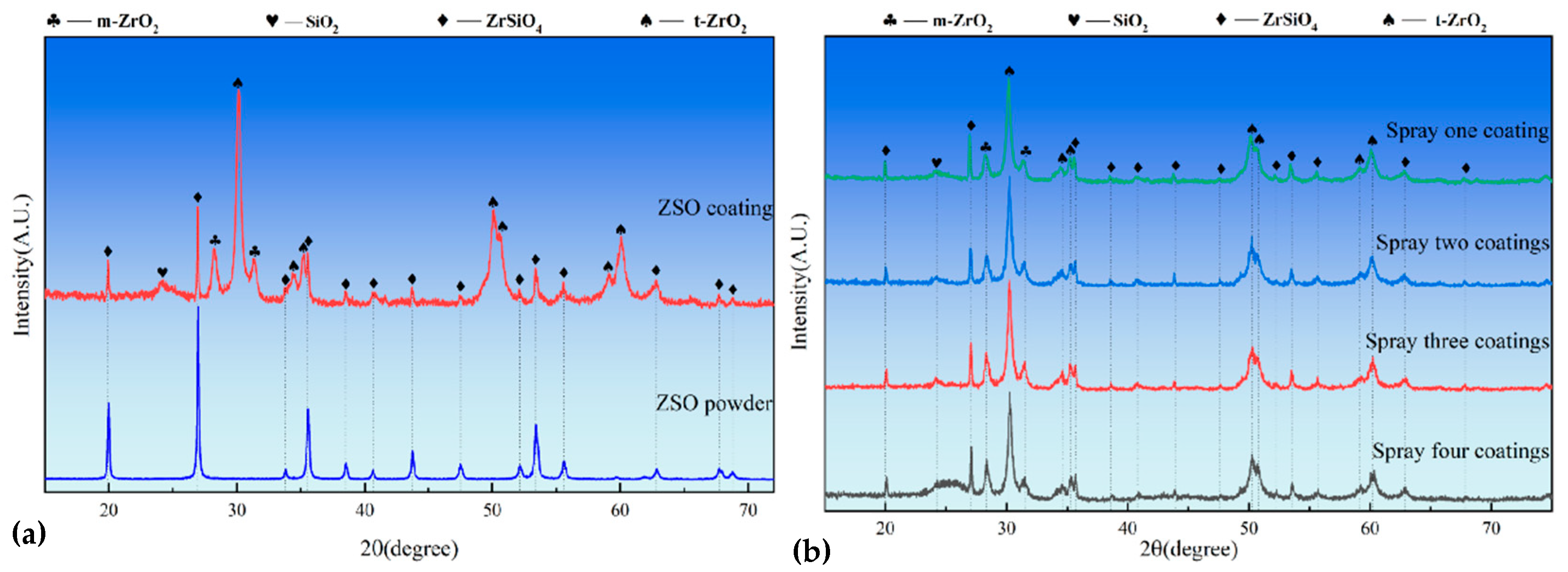

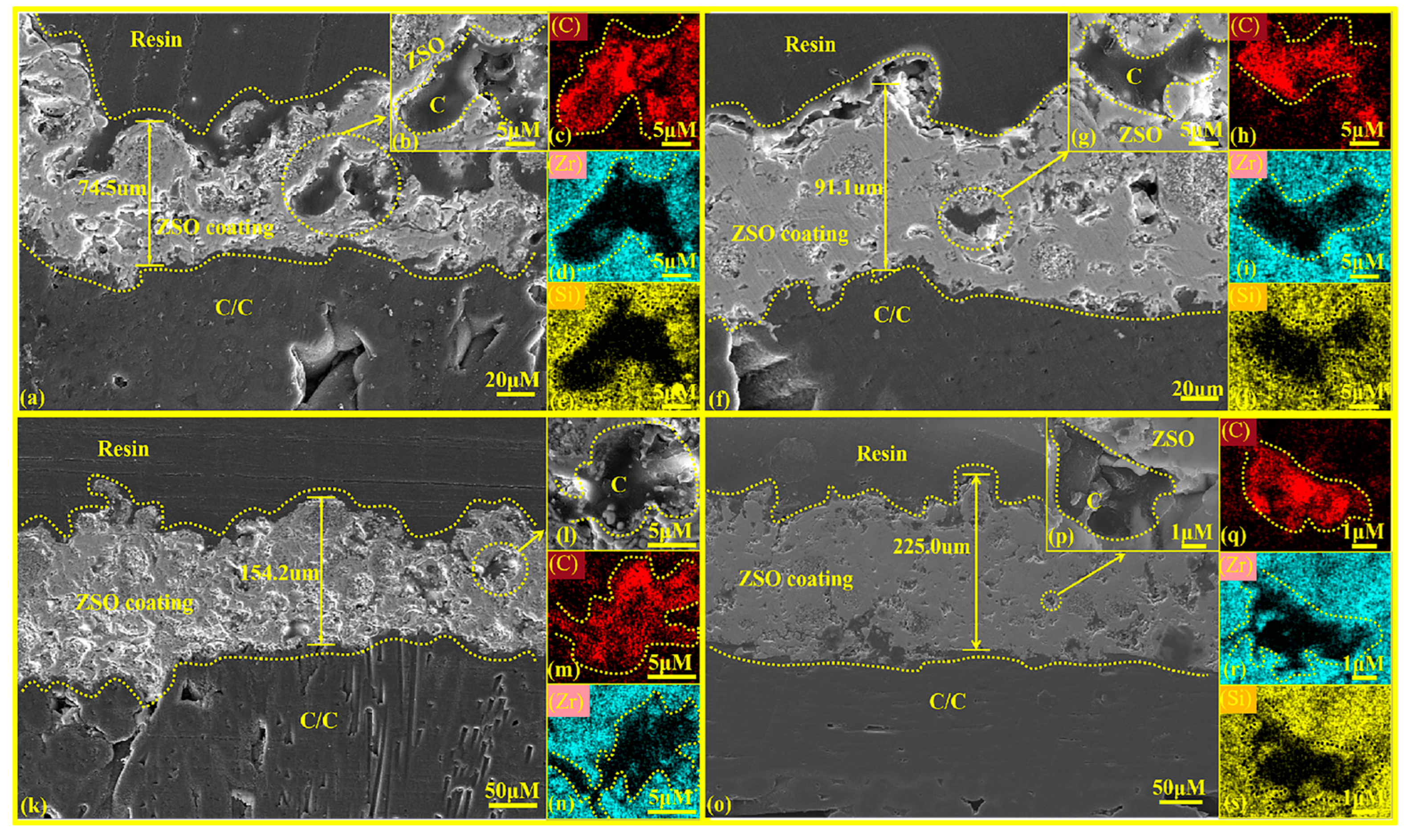



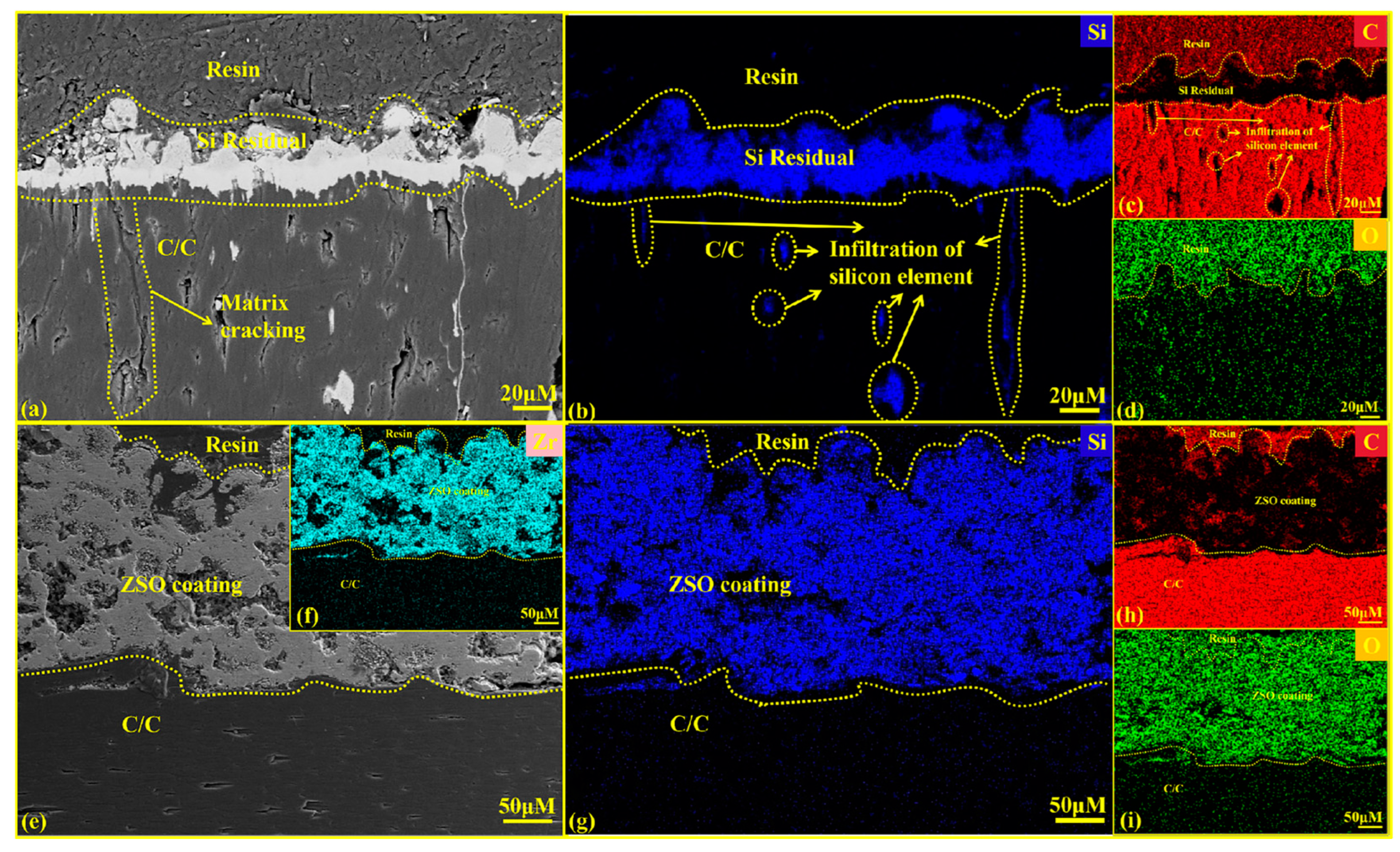
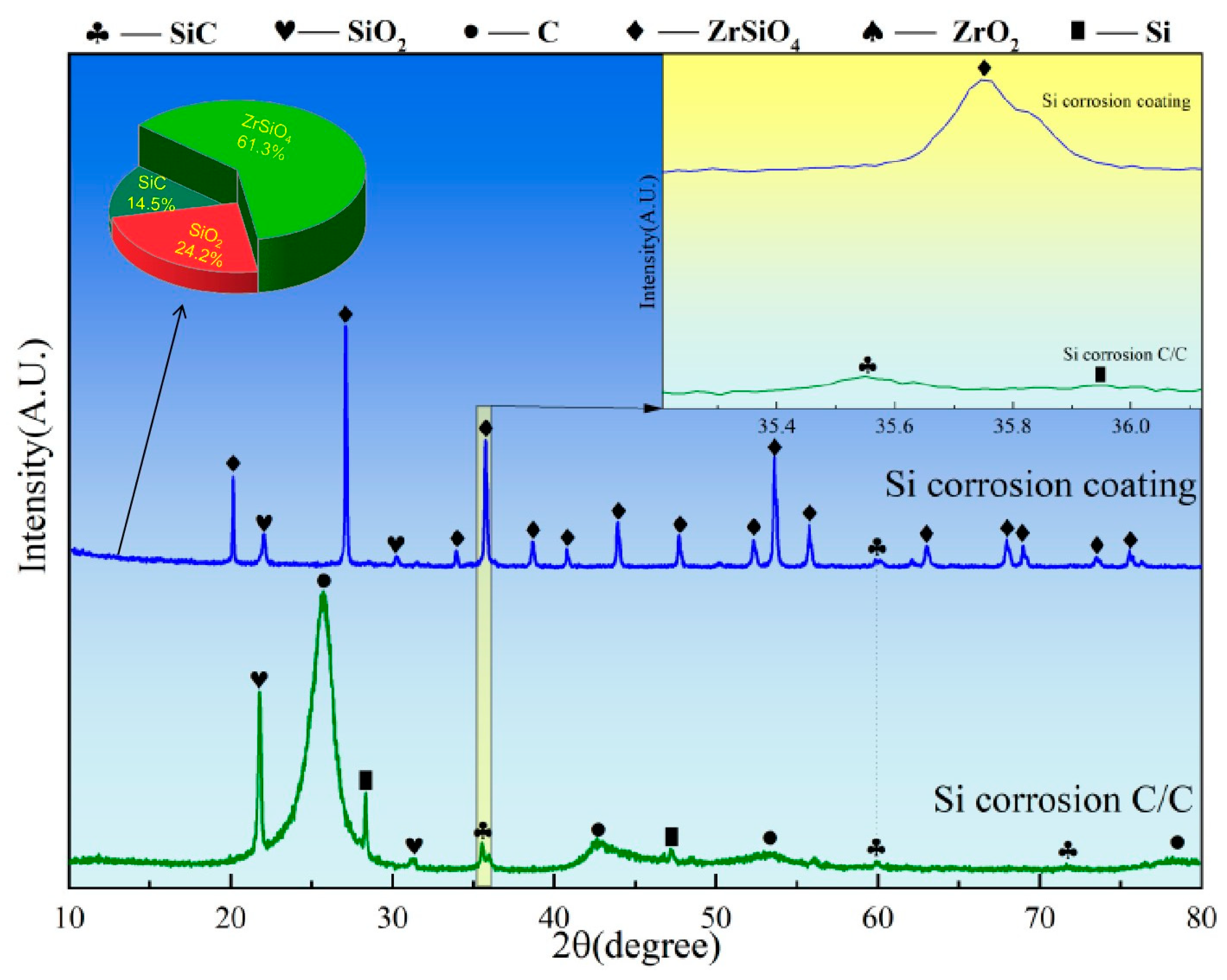
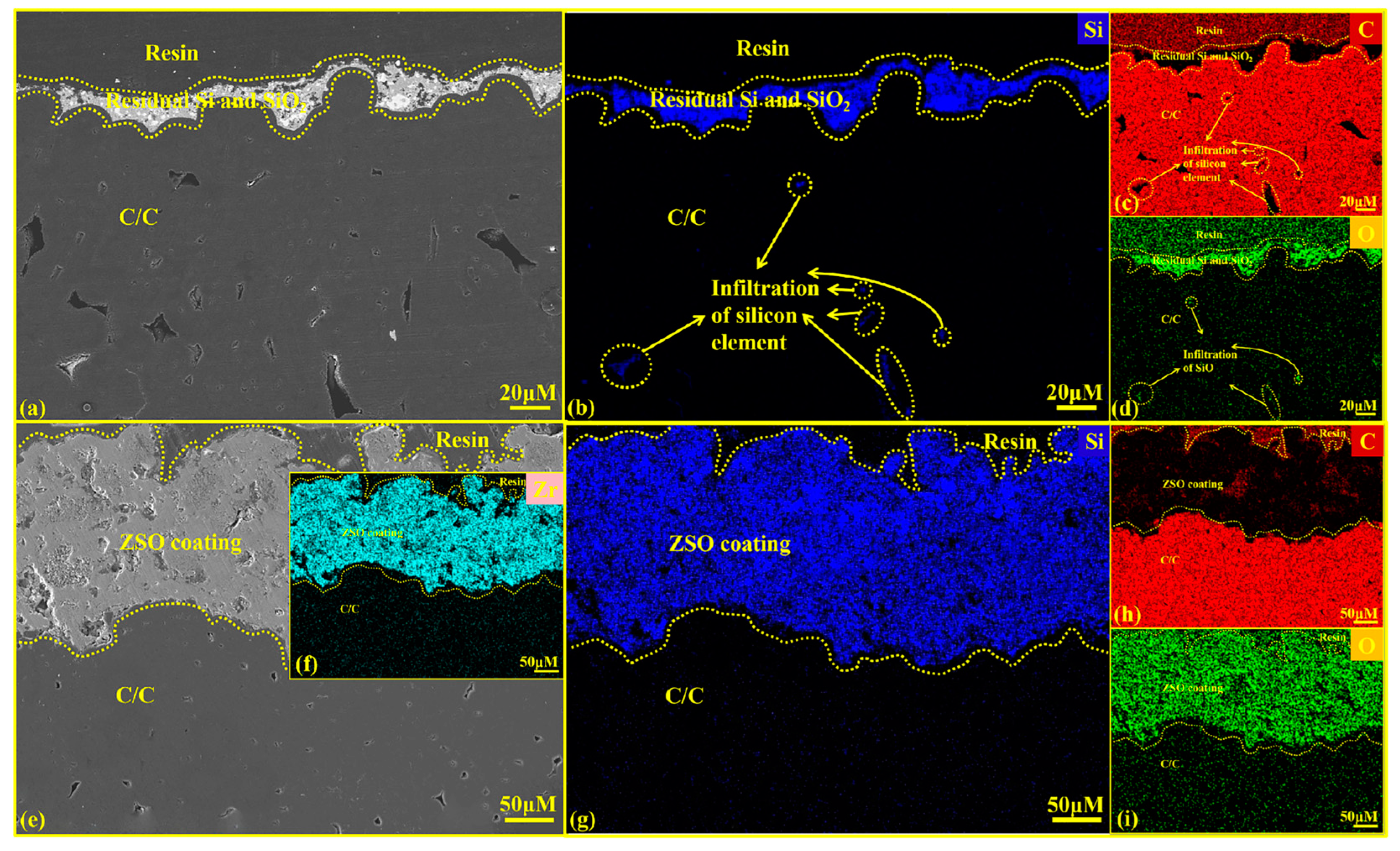
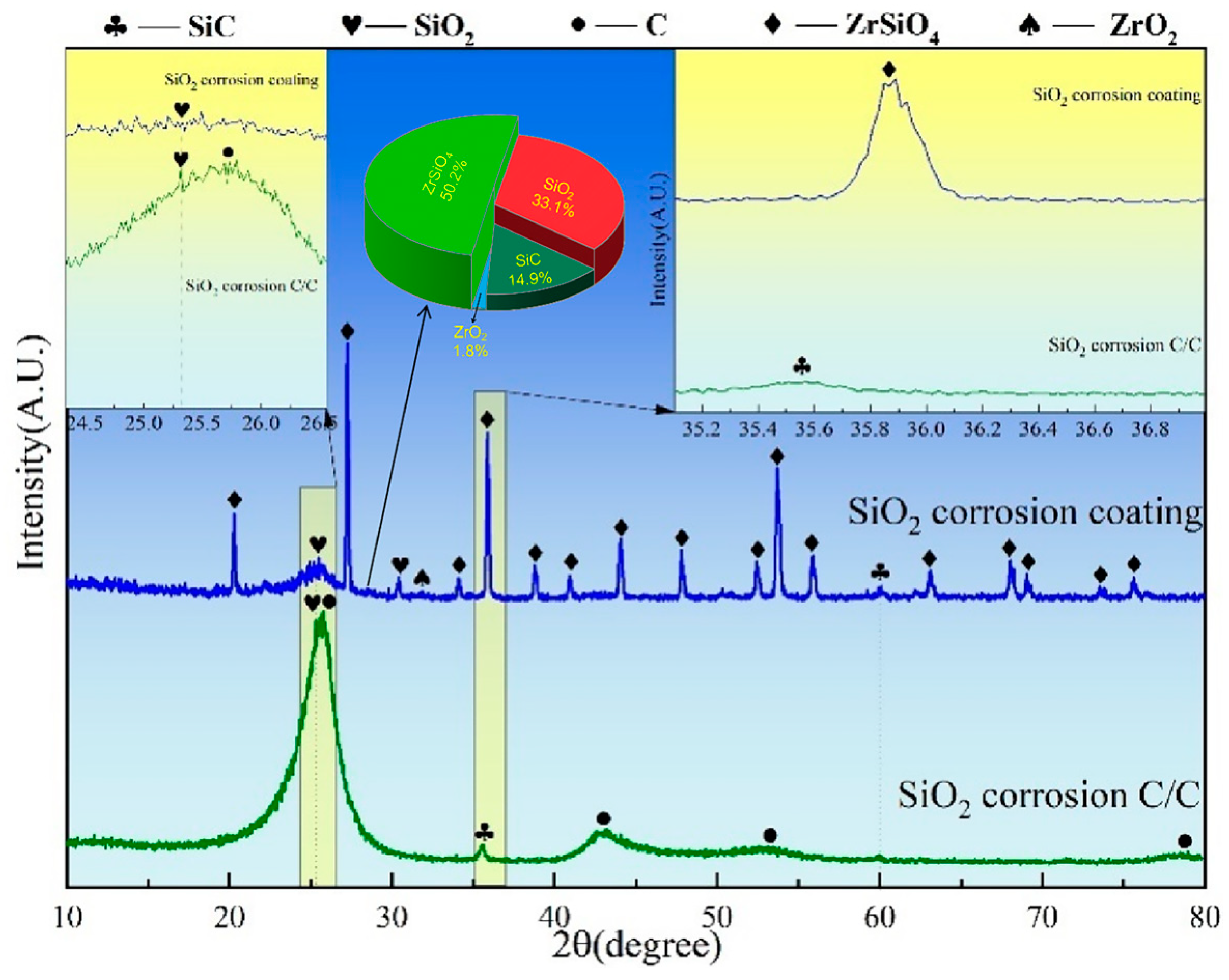
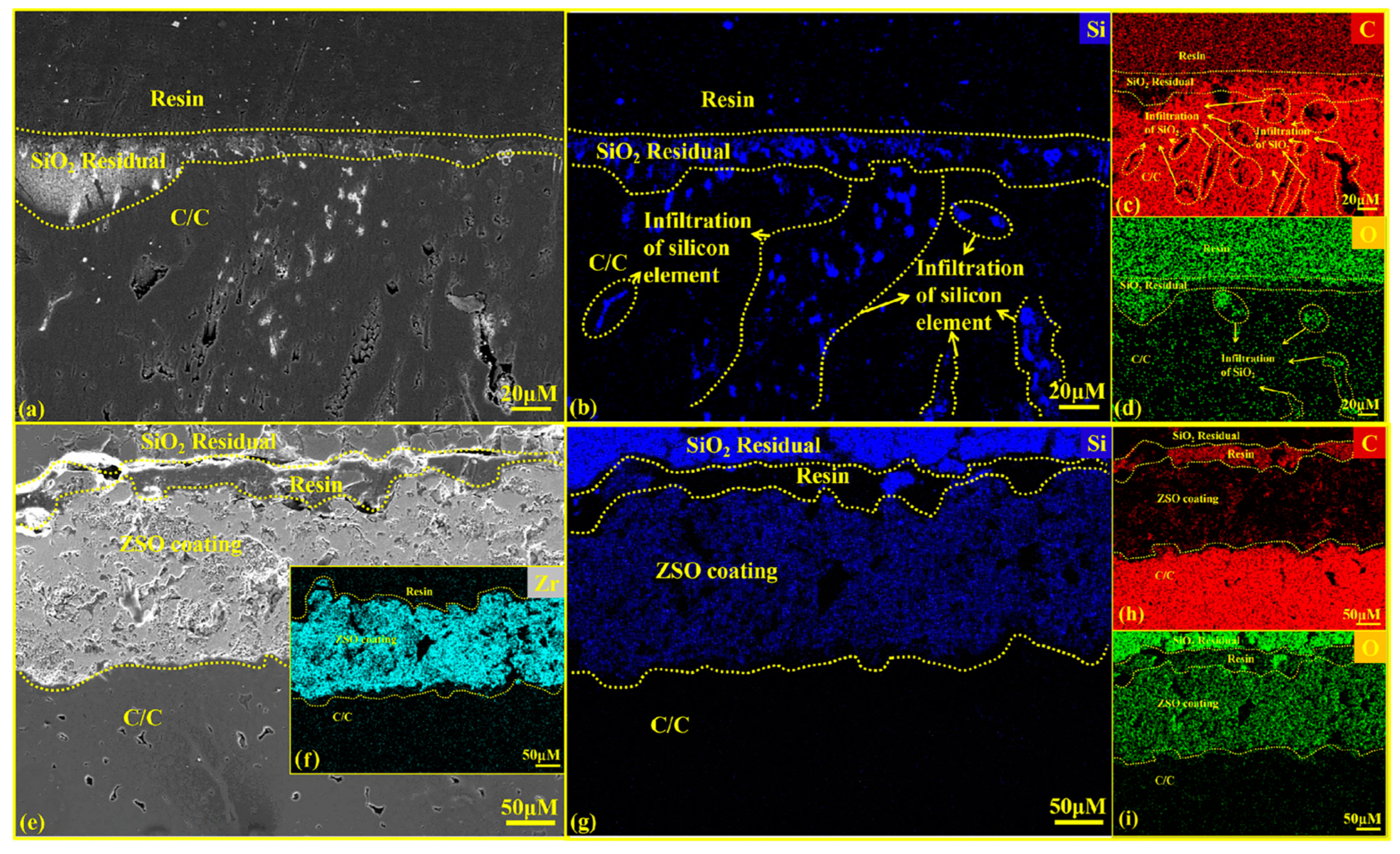
| Spraying Parameters | Values |
|---|---|
| Spraying current | 350 A |
| Spraying voltage | 80 V |
| Primary gas (Ar) flow rate | 40 L/min |
| Secondary gas (H2) flow rate | 6 L/min |
| Carrier gas (Ar) flow rate | 0.017 L/min |
| Spraying distance | 100 mm |
| Powder feed rate | 22 g/min |
| Nozzle diameter | 5 mm |
Disclaimer/Publisher’s Note: The statements, opinions and data contained in all publications are solely those of the individual author(s) and contributor(s) and not of MDPI and/or the editor(s). MDPI and/or the editor(s) disclaim responsibility for any injury to people or property resulting from any ideas, methods, instructions or products referred to in the content. |
© 2025 by the authors. Licensee MDPI, Basel, Switzerland. This article is an open access article distributed under the terms and conditions of the Creative Commons Attribution (CC BY) license (https://creativecommons.org/licenses/by/4.0/).
Share and Cite
Yu, H.; Yang, H.; Wang, D.; Xiao, Y.; Wang, L.; Chen, Z.; Li, W.; Luo, R.; Huang, J. Feasible Exploration Study of Anti-Silicon Element Corrosion Coating for C/C Composites. Coatings 2025, 15, 433. https://doi.org/10.3390/coatings15040433
Yu H, Yang H, Wang D, Xiao Y, Wang L, Chen Z, Li W, Luo R, Huang J. Feasible Exploration Study of Anti-Silicon Element Corrosion Coating for C/C Composites. Coatings. 2025; 15(4):433. https://doi.org/10.3390/coatings15040433
Chicago/Turabian StyleYu, Haijiang, Huiyong Yang, Deteng Wang, Yixin Xiao, Lianyi Wang, Zhi Chen, Wei Li, Ruiying Luo, and Juntong Huang. 2025. "Feasible Exploration Study of Anti-Silicon Element Corrosion Coating for C/C Composites" Coatings 15, no. 4: 433. https://doi.org/10.3390/coatings15040433
APA StyleYu, H., Yang, H., Wang, D., Xiao, Y., Wang, L., Chen, Z., Li, W., Luo, R., & Huang, J. (2025). Feasible Exploration Study of Anti-Silicon Element Corrosion Coating for C/C Composites. Coatings, 15(4), 433. https://doi.org/10.3390/coatings15040433






